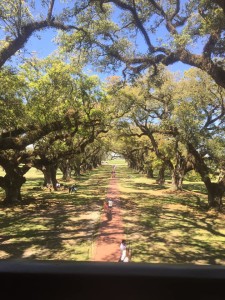Welcome to the forty-fourth issue of CEE News!
I recently returned from New Orleans where I took my mother to celebrate her 80th birthday. Although I live in San Diego and Mom lives north of Houston, we chose New Orleans because seeing the Alvin Ailey Dancers perform was on Mom’s bucket list, and they were scheduled to perform in New Orleans on her birthday. Growing up in Texas, I knew of New Orleans as the Mardi Gras-hosting city of debauchery that young girls like me were to avoid at all costs. So, naturally, the city has always been on my bucket list.
In addition to seeing the Alvin Ailey troupe perform at the Mahalia Jackson Theatre, spending an entire day exploring City Park, and dropping into the French Quarter for a stroll and a taste of the original muffuletta sandwich from Central Grocery, it’s how we bookended our trip that left the greatest impact on me.
 On Day 1, we drove about 1 ½ hours west of the city to tour Oak Alley Plantation. We chose Oak Alley partly inspired by the gorgeous tunnel of 300-year-old oak trees that line the path to the house. The plantation is also known for its coverage of both the glamorous and indefensibly horrible parts of plantation life, including stories, documents, and displays covering the lives of not only the wealthy family who owned the plantation but also the people enslaved there.
On Day 1, we drove about 1 ½ hours west of the city to tour Oak Alley Plantation. We chose Oak Alley partly inspired by the gorgeous tunnel of 300-year-old oak trees that line the path to the house. The plantation is also known for its coverage of both the glamorous and indefensibly horrible parts of plantation life, including stories, documents, and displays covering the lives of not only the wealthy family who owned the plantation but also the people enslaved there.
While touring the plantation, Mom pointed out a map of Louisiana circa early 1800’s showing every acre on both sides of the Mississippi River from Baton Rouge to New Orleans covered with side-by-side plantations. Most of these plantations harvested sugarcane, and together produced more than half of the sugar consumed in the United States before the Civil War. Louisiana’s agri-industrial complex of 1900 plantations thrived on the backs of over 107,000 enslaved people. Plantations like Oak Alley serve as a monument to the terror of slavery, and a foundation for the structural racism that persists today.
 Which brings me to the last morning in New Orleans when we drove through the Lower Ninth Ward. Nowhere are the ravages of Hurricane Katrina more evident than the largely barren moonscape that defines the Lower Ninth almost 15 years later. The word “Katrina” has become a euphemism signifying national dysfunction. The few residents of the Lower Ninth who have rebuilt continue to struggle against the curses of greed, corruption, and apathy that are woven into the complicated fabric that is America.
Which brings me to the last morning in New Orleans when we drove through the Lower Ninth Ward. Nowhere are the ravages of Hurricane Katrina more evident than the largely barren moonscape that defines the Lower Ninth almost 15 years later. The word “Katrina” has become a euphemism signifying national dysfunction. The few residents of the Lower Ninth who have rebuilt continue to struggle against the curses of greed, corruption, and apathy that are woven into the complicated fabric that is America.
I’m grateful to have spent my mother’s 80th birthday in New Orleans with her, and am richer for having seen these haunting sites of America’s yesterday and today for myself.
.
Sheri Nasim | President & CEO


